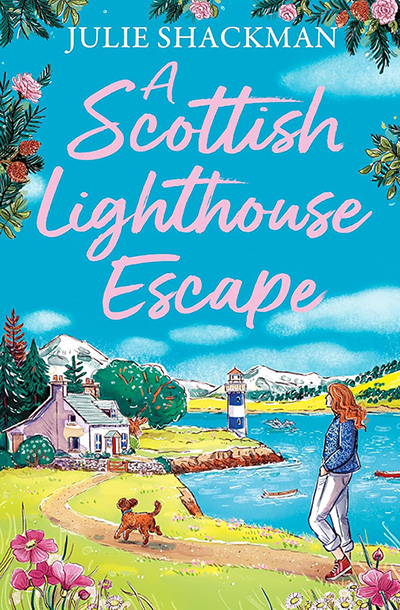
wo of the biggest compliments I ever received were from readers of my feel-good romances, who recently sent me the following messages on social media:
The first said, “I loved your descriptions and settings. It felt like I was there.”
Another said, “It’s as if Julie Shackman’s locations become a character in their own right.”
Whoa! Talk about making my year—let alone my day! As a writer who loves to world-build, these comments left me with an emotional and warm fuzzy glow!
Personally, I love to read books where the world springs to life from the page and catapults me into the story. As I read, there’s nothing more I enjoy than seeing in my imagination the places I’m reading about.
Novels that conjure up pictures in my head of where the characters work, live, love, and exist have a very special place in my heart. You can see the buttery sun cascading down the castle walls, smell the woodsmoke spiraling through the forest, or hear the flapping of dragon wings, as it soars over the erupting volcano.
But as writers, how can we achieve descriptions of vivid colors and make them reality when we world-build? How can we make our settings seem real and spring from the page? What techniques can we use to make our readers feel like they are right there in the middle of the action, too?
Two of my favorite authors, Jenny Colgan and Trisha Ashley, who are spellbinding with their world-building, create amazing settings for their books.
You can literally feel the sea breeze on your face and taste the sea salt on your tongue whenever Jenny puts pen to paper. She will describe a Highland setting to perfection.
As for Trisha, she is a master at creating and stirring up visions of windswept hillsides and old houses with mullioned windows. Yorkshire leaps from the pages.
We all have special places in our hearts for settings we’ve read about or perhaps they are just memorable to us because of how the author crafted them. Whether it’s the shadowy crime-ridden Gotham City for Batman or the fictional town of Amity, where a great white shark struck fear into the locals, such worlds stay with us for a variety of reasons, long after we finished reading.
That’s if the author has managed to make their world compelling.
Name of the Game
For my own feel-good romances set in Scotland, I tend to create imaginary places and come up with my own town or village names. I love doing this, and each time, it’s a thrill to start over with a brand-new setting to create and a new town or village name to conjure up.
I think I’m rather like a magpie—I tend to steal elements of real-life places that I’ve been to or read about and then mold them together to make up my own settings. It might be an old Gothic church I spied in one town and a crumbling castle in another.
Then I’ll mull over possible place names and not only try to choose something that sounds good but also reflects the appearance, location, or atmosphere of my world.

For example, in my first Scottish Escapes title, A Secret Scottish Escape, I came up with the setting of Loch Harris, which is loosely based on Loch Lomond. I wanted somewhere that I could create a stunning loch, breath-taking scenery, and have a jetty to house an old boat shed.
In A Scottish Lighthouse Escape, the setting is the fictional Scottish Highland seaside town of Rowan Bay. As you might have guessed from the title, a lighthouse features in the story, and so I had great fun describing the wildlife there, the bay itself, and the majestic waves hitting the rocks.
Try to adopt the same approach for your world or town, and create a name that encapsulates the spirit of your world. Perhaps it reflects the scenery, lakes, or history of the area. Maybe it harps back to an aspect of its industrial past? Let your imagination run free and try to come up with a unique name that not only fits your new world but also mirrors it.
There are so many memorable worlds and settings from well-known books with amazing names that live long in literary history: Narnia, Westeros, Neverland. Try to make sure that yours is equally as creative and memorable.
Wish You Were Here
Create a world in your novel or short story that pulls your reader in and makes them want to visit. You will have achieved something very special.
But how?
Effective world-building is vital—if we, as authors, are to achieve that element of reality. If we can do this, it is every bit as enjoyable for us as it is for the reader.
Fictional world-building that manages to create pictures in the minds of your readers will make them feel like they are there alongside your characters, living and breathing the story. Use color, smell, sight, touch, and taste to paint a picture of where your characters are. Describe unique buildings and snaking streets or glossy doorways and the brittle feel of wooden shop shutters. There might be the rich tang of coffee or the bitter scent of smoke from a nearby foundry.
Do that well, and you will hook your reader!
Details! Details!
In order for your reader to feel immersed in your world, you need to bring the setting to life.
Think of well-known fictitious worlds that have achieved just that. For example, think of Hogwarts in the Harry Potter novels with the school’s imposing, mysterious location, medieval turrets, and magic woven into every stone.
Or perhaps you are a fan of The Hobbit with its weird and wonderful creatures and its fantastical land of Middle Earth. You could be a keen artist, wishing to follow in the footsteps of Tolkien and come up with maps of your new world.
So, what do novels like these have in common?
You certainly don’t have to be a keen, fledgling cartographer. But what you should strive to do is paint a picture on the page that makes the reader feel like they are following in the footsteps of your characters.
Hogwarts and Middle Earth are both memorable with settings that fizz from the page, providing a sense of place that the characters complement. Use your unique storytelling and imaginative prowess to describe how your settings look, what the atmosphere is like, and how it feels for your characters to be there.
One of a Kind
Perhaps your world has stringent laws and customs. Maybe it has a controlling hierarchy that refuses to have any sort of anarchy.
Introducing such aspects as these above will give your setting a different dimension as well as another storyline to explore with your characters.
Make your world stand out with unique architecture or an unusual history. Again, this could be implied and explored further in the name you choose for your novel or short story setting.
Details like this, could infer a compelling, subversive element that your characters have to challenge. What would this mean for your world? How would it change? What would the impact be?
For instance, think of the underbelly of lies and deceit that exists in the power struggles of Game of Thrones. There are shadowy hallways and sinister castles as warring families battle to seize power.
History in the Making
Everywhere we live—whether town, city, country, or continent—these places possess their own unique characteristics and history. That’s what makes our planet such a beautiful, original, and diverse place.
Make your novel’s setting no exception.
Create an imaginative backstory of how your setting came to be, by whom and why. How was it originally started? Were there warring families or maybe someone was running from something and had to start over?
For example, you have so many opposing factions in the Star Wars franchise, where ancestors created various settlements and planets, only for them to be conquered by their enemies. Characters could have a special connection to a place, or they could possess a dark secret that is hidden in the place where your story is set.
Bring the backstory and evolution of your world to life. Sprinkle these details throughout your novel, and weave them into the fabric of the background of your world. This will make your setting more relatable and real to your reader.
Law and Order
With novels such as Game of Thrones and The Hunger Games, law and order, rebellion, and war feature heavily.
This aspect is something you could incorporate into your own story. Not only would these types of events greatly impact your characters, but they also provide a great excuse for tension and intrigue!
Imagine clandestine characters meeting up on cobble streets or dingy taverns to discuss their battle plans.
Such details will make your characters, story, and place pop from the page and create more atmosphere.
You wouldn’t have a trio of villains meeting on a sunny day at the beach (well, you could, but it wouldn’t be very atmospheric).
Instead, enhance the themes and pace of your story by using your world to its full advantage to create tension and drama. A place with dark, looming doorways and furtive-looking characters loitering on every street corner will make any reader curious to know more.
Full of Character
Characters interact with your setting, whether it be a factory, house, or stately home and such places can trigger memories, heartbreak, or guilt, depending on your story.
They could adore their world, or conversely, it may feel like a prison to them and they are desperate to escape.
But it’s also about the character of your fictional world and not just the people who inhabit it. Give your setting enough character and detail in its own right, and it will become a living and breathing entity, just like your protagonist and antagonist.
Your setting too will have a story to tell.
Just think of the likes of Oz in The Wizard of Oz by L. Frank Baum and Wonderland from Alice in Wonderland by Lewis Carroll.
World-building is one of my favorite parts of writing a new book. It gives me free reign to put my shiny, new set of characters into a brand-new place, brimming with new landscapes, secrets, and location.
So, when you next begin to pull together ideas for your novel’s world, remember that the setting you will carve out of nothing really is your oyster. If you live and breathe it in your imagination, your reader will, too!
Happy world-building and good luck!
***

Julie Shackman is a feel-good romance author from Scotland and is published with the HarperCollins imprint One More Chapter. Visit her website: julieshackman.co.uk. Connect with her on social media: X @G13Julie, Instagram @juliegeorginashackman, and Facebook @julie.shackman.